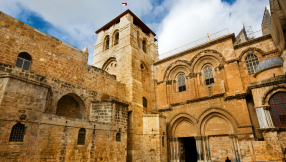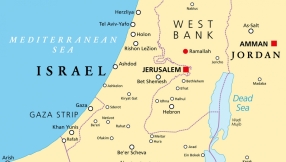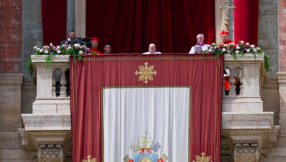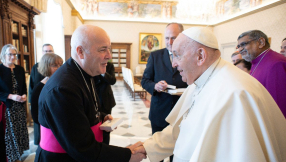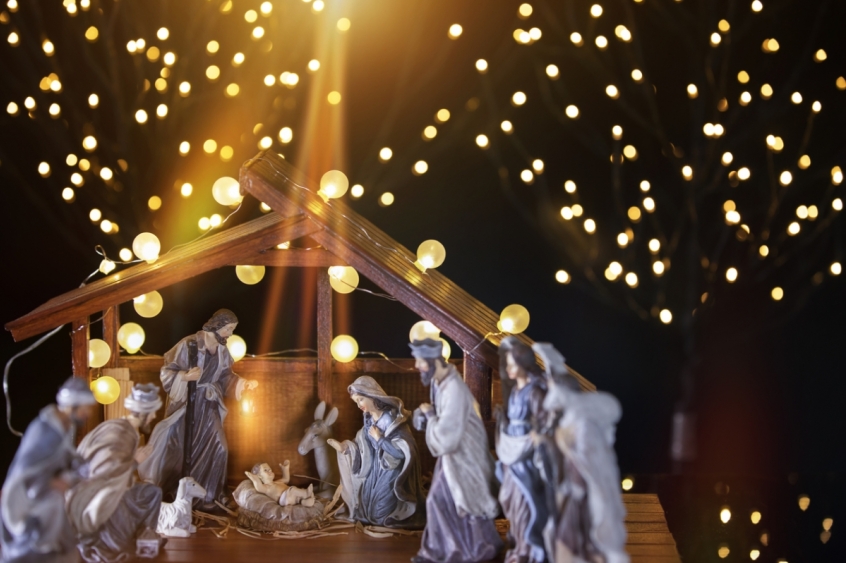
The writer of the Letter to the Hebrews reminds Christians that they are surrounded by a great "cloud of witnesses." (NRSV) That "cloud" has continued to grow in size since then. In this monthly column we will be thinking about some of the people and events, over the past 2000 years, that have helped make up this "cloud." People and events that have helped build the community of the Christian church as it exists today.
Today, what we might call the "traditional Nativity scene" is a well-known feature of Christmas. It is found in churches, homes, even in some municipal settings. They come in different shapes, sizes, and appearances. The features are well known. In a stable, often with some straw scattered on the ground, the models of the Holy Family are placed centre stage. Jesus lies – swaddled – in a manger (an animal feeding trough) filled with hay.
Mary and Joseph gaze at the baby. Models of oxen, donkeys (and sometimes sheep) are placed at the edges of the scene. Perhaps there are figures of attendant shepherds, who have hurried down from the surrounding hills. There may be an angel – or more than one – with wings outstretched above the Holy Family.
Often the three magi will be there too (with their gifts of gold, frankincense, and myrrh). They are misplaced in time and location from their actual visit to the toddler Jesus, in "the house" (Matthew 2:11), in Bethlehem where the family were living at that point in time. And we do not know how many of them there were.
As well as the static Nativity tableaux, there are also "Living Nativities", enacted in churches and schools (usually with children taking the parts), or on the streets of modern towns and cities (where adults usually act out the events).
However, whether formed from models, or with actual people, the image of the Holy Family, manger, stable, animals, and visitors, is now well known. And, of course, the same scene is depicted on Christmas cards when these are focused on the actual Nativity, rather than on vague wintry scenes. The ideas of no room at the inn, and birth in a stable, are firmly fixed in the remembrance of Christmas.
A composite image
The traditional Nativity Scene, as described above, is an amalgamation of New Testament evidence combined with assumptions which have now become so familiar we take them "as gospel." In reality, there are no Nativity narratives at all in the Gospels of Mark and John. The one in Matthew only involves the magi, who clearly appeared when Jesus was about two years old, hence Herod's decision to order the killing of "all the children in and around Bethlehem who were two years old or under, according to the time that he had learned from the wise men" (Matthew 2:16). And the magi visited the family in a "house". The Greek word oikia clearly indicates this. No stable was involved.
All the things we usually associate with Bethlehem at Christmas are found in the Gospel of Luke chapter 2. It is here that we find the journey to Bethlehem as the result of a Roman census. Then we are told about the birth of Jesus and that Mary "wrapped him in bands of cloth, and laid him in a manger, because there was no place for them in the inn" (Luke 2:7 NRSV).
The word that lies behind the familiar idea of an "inn," with no room for the heavily-pregnant Mary (kataluma in Greek) is more accurately translated into English as "room in a house," or "guest room." The word was used in the sense of "inn" in the Greek translation of the Old Testament (the Septuagint), but the same word appears in Luke 22:11, where we are told that "The teacher asks you, 'Where is the guest room, where I may eat the Passover with my disciples?'" The word is similarly used when Mark also describes the room used for the Last Supper (Mark 14:14). It is not translated as "inn" then, and the contrasting translations give us a very different mental image of the living spaces being referred to at Christmas and at Easter, when the same word is actually used for both occasions.
While context may justify the difference, it is more likely that the idea of "no room at the inn" is based on something of an assumption in the process of translation. There clearly was no room available for the pregnant Mary – and that is stark. But it is likely that there was no room at the home of a relative, or in the house of someone else who was taking in visitors as paying guests.
Incidentally, when Luke later refers to an "inn," in the Parable of the Good Samaritan (Luke 10:34), he uses the more general Greek term pandocheion. It seems clear that – despite the disruption this will cause to countless Nativity plays and Nativity scenes – we need to set aside the familiar image of the inn, and the innkeeper, at Bethlehem.
Luke then recounts the angelic appearance to the shepherds, who rushed down to Bethlehem where they "found Mary and Joseph, and the child lying in the manger" (Luke 2:16). There is no mention of a stable at any point; nor of oxen and donkeys standing by. There are no angels there either, after their appearance earlier to the shepherds out in the fields.
The mention of a "manger" has usually been taken as indicative of a location in a stable. However, the manger could easily have been in an open courtyard (even starker than our usual image); or in the lower part of a dwelling, where animals were kept (rather more homely than often imagined); or in a room shared between people and animals (in a regular living space, among the family members there), rather than in a guest room. A second-century Christian tradition stated that it was in a cave, used for stabling, so that idea is old. However, the gospel itself is not specific.
What is clear is that the couple appear to have been alone, as there is no mention of supportive family members present. And – however we envisage that location at the "inn" or, rather, the "guest room" – the key point is that there was "no place for them" in it. Even if Jesus was born in the regular living-space of a lower-class Bethlehem family (alongside their animals), we are still left with the impression of no room for him in the place normally set aside for guests. That is central to the account and Luke is making a significant point by stating it so clearly.
There can sometimes be a tendency to "normalise" the context of the birth, when envisaging it in a setting different to that of the traditional stable. And, of course, the very idea of God's Son being born in any human social setting is breathtaking. However, Luke stresses the use of the "manger" (both in the account of the birth and as the "sign" given to the shepherds by the angel) for a reason. Given that several babies were probably born in Bethlehem that night, the location of the one referred to is distinct and significant. Poverty and marginalisation are vividly implied, and consistent with the character of Luke's presentation of the gospel.
What is undeniable is that significant parts of our mental image – and the actual images of the Nativity scene, as found in the famous Christmas tableaux – are based on assumptions that go beyond the gospel text. Christian communities over the centuries developed these based on where a manger was expected to be found.
But these images are also indebted to St Francis of Assisi's imaginative contribution to the way that we portray Christmas.
The 800th anniversary of the Nativity scene as we now know it
In the winter of 1223, less than three years before his death, Francis came up with a plan to make the Christmas story more vivid to those around him, and rooted in a context which spoke of the physicality of the actual birth of Jesus. We are not the first to be concerned that there is too much tinsel in many people's image of what the birth of Jesus was actually like. It troubled Francis, too, that many had lost their awareness of the reality behind the season.
Francis had visited the Middle East, and this had included the place that was traditionally acclaimed as where the birth of Jesus had occurred. The experience had moved him deeply.
To convey something of the reality of the Incarnation, Francis resolved to put together a "living crib," a Nativity scene, in the little Italian village of Greccio in the Rieti Valley. He already had a track record of using vivid strategies in his teaching. For example, the story of Francis preaching to the birds is actually a sanitised version of the reality, when he preached to the scavenging and carrion-feeding birds outside the town, at the rubbish dump and where the bodies of executed criminals were left to rot. What he actually did was a dramatic demonstration of the gospel being brought to the marginalised and rejected. Vivid visual preaching strategies were important to Francis.
Shortly before Christmas, Francis enlisted the support of a local nobleman who provided an ox, a donkey, and a stable. Thomas of Celano, the first biographer of Francis, described the scene:
"The manger is prepared, the hay is carried in, and the ox and the ass are led to the spot... Out of Greccio is made a new Bethlehem."
Around the scene, the local people stood with candles and blazing torches, which lit up the night. The gospel passage was sung by Francis, who then preached to the villagers, explaining the significance of the birth of Jesus. It was then that – according to Thomas of Celano – a miracle occurred. One of those present saw a vision, in which a real child was seen to be lying in the hay; when Francis approached the manger, the child awoke. The message of the vision was clear: by putting together the Nativity scene with sincere faith, those present had come into the presence of the Christ Child. It was an extraordinary claim and was clearly rooted in why Francis had set up the scene in the first place.
Today, in Greccio, a stable is erected each year, and the local villagers and Franciscans once again reenact the Nativity scene, which Francis had brought together in order to bring people closer to the actual events at Bethlehem. In towns and villages across Umbria, and nearby provinces today, medieval street scenes are recreated with the Nativity scene at the centre. Visitors may stroll among the stalls of traditional crafts or follow a prescribed route which takes them past enactments of events drawn from the biblical account.
As we celebrate Christmas, many of us will be engaging with a visual form of it which is 800 years old this year. And all of us will be taking part in the celebration of an event which –for all the debates over its details – goes to the heart of the Christian faith.
Martyn Whittock is a historian and a Licensed Lay Minister in the Church of England. The author, or co-author, of fifty-six books, his work covers a wide range of historical and theological themes. In addition, as a commentator and columnist, he has written for several print and online news platforms and been interviewed on TV and radio news and discussion programmes exploring the interaction of faith and politics. His recent books include: Daughters of Eve (2021), Jesus the Unauthorized Biography (2021), The End Times, Again? (2021), The Story of the Cross (2021), and Apocalyptic Politics (2022). His latest book, American Vikings: How the Norse Sailed into the Lands and Imaginations of America (2023), explores evidence for Norse exploration of North America and its impact on culture and politics there.










